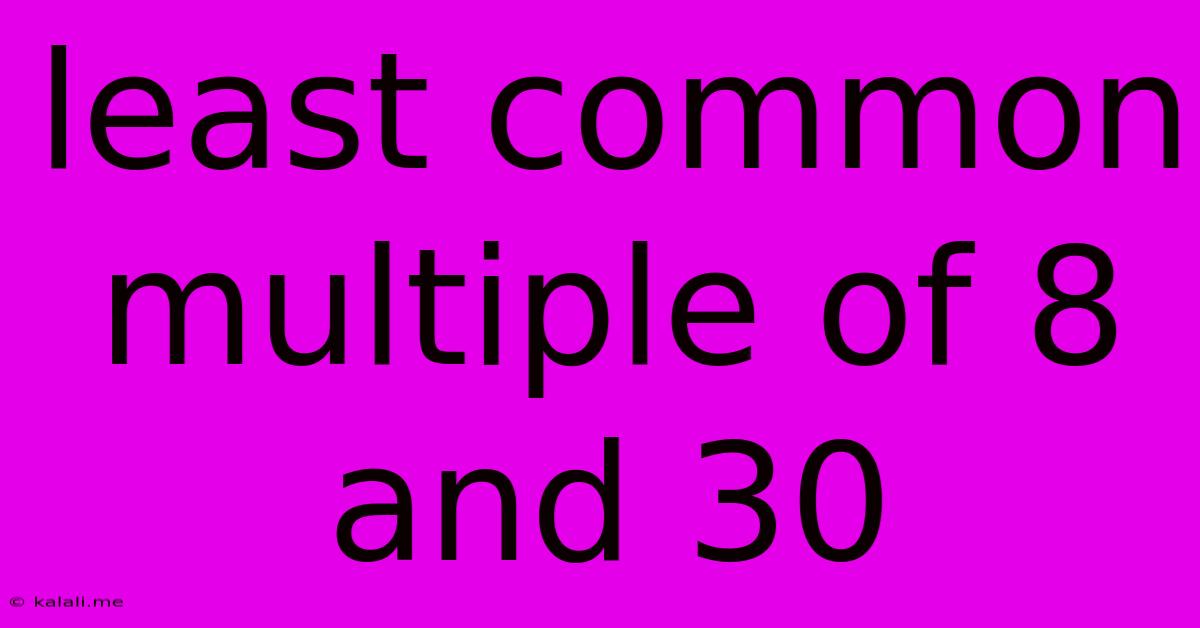Least Common Multiple Of 8 And 30
Kalali
Jun 14, 2025 · 3 min read

Table of Contents
Finding the Least Common Multiple (LCM) of 8 and 30
Finding the least common multiple (LCM) is a fundamental concept in number theory and has practical applications in various fields, from scheduling to music theory. This article will guide you through different methods to calculate the LCM of 8 and 30, explaining the concepts clearly and providing you with a solid understanding of the process. Understanding LCM is crucial for anyone working with fractions, simplifying expressions, or solving problems involving periodic events.
What is the Least Common Multiple (LCM)?
The least common multiple (LCM) of two or more integers is the smallest positive integer that is divisible by all the integers. For example, the LCM of 2 and 3 is 6 because 6 is the smallest positive integer divisible by both 2 and 3. Finding the LCM is often necessary when dealing with fractions, particularly when adding or subtracting fractions with different denominators.
Methods for Calculating the LCM of 8 and 30
There are several ways to determine the LCM of 8 and 30. Let's explore two common methods:
1. Listing Multiples Method
This method involves listing the multiples of each number until you find the smallest multiple common to both.
- Multiples of 8: 8, 16, 24, 32, 40, 48, 56, 60, 72, 80...
- Multiples of 30: 30, 60, 90, 120...
By comparing the lists, we can see that the smallest multiple common to both 8 and 30 is 120. Therefore, the LCM(8, 30) = 120. While simple for smaller numbers, this method becomes less efficient for larger numbers.
2. Prime Factorization Method
This method is more efficient, especially for larger numbers. It involves finding the prime factorization of each number and then constructing the LCM using the highest powers of each prime factor present.
- Prime factorization of 8: 2³
- Prime factorization of 30: 2 x 3 x 5
To find the LCM, we take the highest power of each prime factor present in either factorization:
- Highest power of 2: 2³ = 8
- Highest power of 3: 3¹ = 3
- Highest power of 5: 5¹ = 5
Now, multiply these highest powers together: 8 x 3 x 5 = 120. Therefore, the LCM(8, 30) = 120. This method is generally preferred for its efficiency and systematic approach.
Understanding the Result: LCM(8, 30) = 120
The least common multiple of 8 and 30 is 120. This means that 120 is the smallest positive integer that is divisible by both 8 and 30 without leaving a remainder. This number is crucial when working with fractions involving 8 and 30 as denominators, allowing for easy addition or subtraction.
Applications of LCM
The concept of the least common multiple extends beyond simple number theory. It finds practical applications in various areas, including:
- Scheduling: Determining when two or more events will occur simultaneously. For example, if two events repeat every 8 days and 30 days respectively, they will coincide every 120 days.
- Music Theory: Finding the least common denominator of rhythmic patterns.
- Fractions: Adding and subtracting fractions with different denominators.
By mastering the methods for finding the LCM, you equip yourself with a valuable tool for solving a range of mathematical problems and understanding various real-world scenarios. The prime factorization method, in particular, provides a robust and efficient approach, particularly useful when dealing with larger numbers.
Latest Posts
Latest Posts
-
Intellectual Disabilities Are Characterized By Significant Limitations Both In
Jun 15, 2025
-
L I M In P India
Jun 15, 2025
-
A Chisel Used To Cut V Grooves And Square Corners
Jun 15, 2025
-
What Is The Least Common Multiple Of 6 And 24
Jun 15, 2025
-
What Is The Smallest Unit Of Data In Computer
Jun 15, 2025
Related Post
Thank you for visiting our website which covers about Least Common Multiple Of 8 And 30 . We hope the information provided has been useful to you. Feel free to contact us if you have any questions or need further assistance. See you next time and don't miss to bookmark.